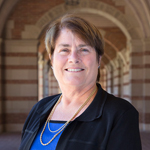Victoria Sork

I study how tree populations exist and persist. To do this, I integrate theories and methods from ecology, evolutionary biology, and population genetics. Because genetic diversity is a key ingredient to the ability of populations to respond to environmental change, one element of my research explores how genes move within and among landscapes through pollen dispersal. In addition, I am curious about how seeds move because seed dispersal is key to the regeneration of populations. Both pollen and seeds can be dispersed by animals, which mean that we must understand how birds and bees and bats and other mammals (to name a few) move pollen and seeds. If animal pollinators and seed dispersal agents disappear, many tree species are jeopardized. I often say that my research goes from the DNA sequence to the landscape because I use genetic tools to understand the landscape processes. Our research group conducts studies in Central America, Mexico, Africa, South America, North America, and especially California. In California, I am studying the impact of landscape change on oak populations and using this information to develop priorities for conservation that will enhance the long-term survival of oaks in the face of climate change. By studying tree species, I am always focusing on the plants that define the ecosystem. Thus, my research generates information on the ecological and evolutionary concepts that shape natural populations, and provides criteria to manage their long term survival.
